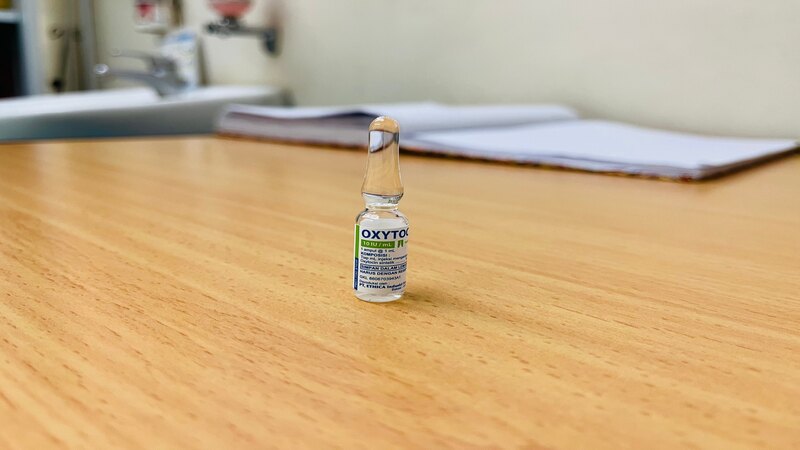
Oxytocin is also known as the love drug. It was first synthesized by Vincent Du Vigneaud in the 1950s and even received a Nobel prize for his discovery. Oxytocin is the hormone which act as the chemical messenger in the brain which controls the labor , childbirth and lactation in the female reproductive system.(1)
In this article we will discuss in detail about oxytocin, how to control it, when to use in labor, and what happens if the levels are altered.
What Is Oxytocin?
Oxytocin per se is a natural hormone which is synthesized from the hypothalamus of the brain and secreted by the posterior pituitary gland. It helps in uterine contraction during labor and childbirth. It also helps during lactation during breastfeeding.(2)
Oxytocin hormone also increases when you are hugging someone or you are experiencing orgasm.(3)
Role Of Oxytocin In Labor

During the child birth, the presenting part of the fetus which is commonly the head of the fetus pushes the cervix then the signal reaches the brain which inturn stimulates the posterior pituitary gland and causes release of oxytocin in the blood. From the blood oxytocin goes to the uterus and it promotes contractions.(4)
When the oxytocin causes uterine contraction , the release of oxytocin increases by the positive feedback in the posterior pituitary and the intensity and frequency of the contraction increases. It in turn helps in release of prostaglandins which causes more contractions and this way vaginal delivery is carried out.(5)
How Are Oxytocin Levels Controlled?
Oxytocin hormone production and secretion is controlled by the positive feedback mechanism of the brain. This means if the hormones release it stimulates the organs and in turn the hormone releases more. To give an example of this- when the oxytocin released it causes uterine contraction which in turn stimulates to release more oxytocin.
Again during lactation this positive feedback reflex affects the milk ejection reflex. When the baby suckles the nipple of the mother during breastfeeding, it causes an increase in oxytocin in the blood which causes secretion of milk from the breast. This continues till the baby suckles. It can be self limiting.(6)
What Happens When Oxytocin Levels Are Low?

Levels of oxytocin are rarely low. But it can be low in a condition known as panhypopituitarism which causes levels of all the hormones to be low.
If the levels of oxytocin is low it can prevent uterine contraction during labor and childbirth, it also prevents the ejection of breast milk during lactation.
Researchers are still in search of what exactly happens if there is low level in oxytocin. It is found that autism or severe depressive disorders, anorexia nervosa are linked to the low levels of oxytocin.(7)
What Happens When Oxytocin Levels Are High?
Oxytocin levels high in female patients can cause overactivity of the uterine muscles and it might cause hypertrophy of the uterus muscle and the female is unable to get pregnant since there is less space in the uterus to hold the fetus inside the uterus. In addition, higher levels of oxytocin can also cause emotional disturbances which triggers oversensitivity of the emotional response.(8)
When To Give Oxytocin In Labour

As already discussed in details above, oxytocin can be given during pregnancy, labor and lactation.(9)
- Induction and augmentation of the labor
- To make the cervix soft- for cervical priming
- It should be used for the active management of the third stage of labor- 10 units oxytocin intramuscularly for the prevention of postpartum hemorrhage
- In C section, post placental delivery to prevent PPH
- It can also be given as the treatment of the atonic PPH.
Side Effects Of Oxytocin To The Mother
There are some side effects which affect mothers. They are as follows:(10)
- Uterine overactivity- after giving the mother oxytocin it can cause hyperstimulation of the uterus which can be more than 5 contractions in 10 minutes.
- Uterine rupture- it can happen in patients who have previously undergone c section, myomectomy, multipara, overdistended uterus.
- Hypotension- intravenous bolus dose of 10 units of oxytocin can cause hypotension
- Water intoxication- high dose of oxytocin can lead to low sodium levels, pulmonary edema, convulsions, coma and also death in mother and the newborn.
- Myocardial ischemia and ventricular fibrillation
- Ventricular premature beats.
- Allergic reaction to oxytocin
- Heavy vaginal bleeding
- Nausea
- Vomiting
Side Effects Of Oxytocin To The Fetus

There can be side effects of oxytocin seen in fetuses too. They are listed below:(11)
- Fetal distress
- Fetal asphyxia
- Neonatal jaundice
- Fetal death can also occur due to decrease in uteroplacental blood flow.
- Seizure
- Eye problems
- Problem in respiratory muscle tone
In this article we have discussed in detail about the oxytocin hormone and its mechanism in labor and lactation. But as seen above there are quite a few side effects which harm both the mother and the fetus,so oxytocin should be used without the advice of the doctor. Oxytocin should be given to the patient where there are facilities to monitor both the mother and the fetus.(12)
FAQ’s
1. Why Is Oxytocin Given During Labor?
Oxytocin is given in labor exogenously to promote uterine contraction which in turn promotes the vaginal delivery. If the levels of oxytocin is not sufficient during labor (less contraction) then oxytocin is given intravenously in infusion.
2. Does Oxytocin Make Labor More Painful?
Oxytocin helps in increase in intensity and frequency of uterine contraction which in turn causes pain. Oxytocin does not cause pain but the uterine contraction causes pain.
3. How Long After Oxytocin Does Labor Start?
The half life of oxytocin is 20 minutes. So after administration of exogenous oxytocin within 15 to 20 minutes the effect appears in the mother.
4. What Is The Difference Between Oxytocin And Pitocin?
Oxytocin is the natural hormone which is released in the body to promote uterine contraction. Pitocin is the synthetic form of oxytocin which is given exogenously to promote uterine contraction.
References
- Gerald Gimpl and Falk Fahrenholz, The Oxytocin Receptor System: Structure, Function, and Regulation –
https://journals.physiology.org/ - Heon-Jin Lee, Abbe H. Macbeth, Jerome H. Pagani, W. Scott Young, Oxytocin: The great facilitator of life, Progress in Neurobiology – https://www.sciencedirect.com/science/
- Oxytocin As Medicine – C. Sue Carter, William M. Kenkel, Evan L. MacLean, Steven R. Wilson, Allison M. Perkeybile, Jason R. Yee, Craig F. Ferris, Hossein P. Nazarloo, Stephen W. Porges, John M. Davis, Jessica J. Connelly and Marcy A. Kingsbury Pharmacological Reviews- https://pharmrev.aspetjournals.org/
- Belghiti J, Kayem G, Dupont C, et alOxytocin during labour and risk of severe postpartum haemorrhage: a population-based, cohort-nested case–control study – https://bmjopen.bmj.com/
- The role of oxytocin in parturition -Andrew M. Blanks, Steven Thornton, First published: 22 December 2003 – https://obgyn.onlinelibrary.wiley.com/doi/abs/10.1046/j.1471-0528.2003.00024.x#:
- Journel Of Endocrinology -Tatsushi Onaka, Division of Brain and Neurophysiology, Department of Physiology, Jichi Medical University, Yakushiji 3311-1, Shinotsuke-shi, Tochigi-ken 329-0498, Japan – https://onlinelibrary.wiley.com/doi/abs/10.1111/j.1365-2826.2012.02300.x#:
- Sarah Maguire, Alice Kesby, Rachel Brownlow, Glenn E. Hunt, Marcellinus Kim, Claire McAulay, Jessica R. Grisham, Iain S. McGregor, Anastasia Suraev, Richard C. Kevin, Janice Russell, A phase II randomised controlled trial of intranasal oxytocin in anorexia nervosa, Psychoneuroendocrinology, 10.1016 – https://onlinelibrary.wiley.com/doi/abs/10.1002/eat.22784#:
- Shan Ding, Yong Liu, Huai Tao, Yuxu Zhao, Hongtao Zeng, Yiding Han, Shichen Wang, Zhiheng Chen, Yamei Tang, Wenbin Guo, Chronic intranasal oxytocin alleviates cognitive impairment and reverses oxytocin signaling upregulation in MK801-induced mice, Psychoneuroendocrinology – https://onlinelibrary.wiley.com/doi/full/10.1111/j.1755-5949.2008.00051.x#:
- Lotta Selin, Ulla-Britt Wennerholm, Maria Jonsson, Anna Dencker, Gunnar Wallin, Eva Wiberg-Itzel, Elisabeth Almström, Max Petzold, Marie Berg, High-dose versus low-dose of oxytocin for labour augmentation: a randomised controlled trial, Women and Birth – https://www.sciencedirect.com/science/article/pii/S1871519218303639#:
- Zeng Y, Zhang Y, Zhen M, Lao L, Ma Y, Liu L, Fan D, Ai W. Side-effects of oxytocin in postpartum hemorrhage: a systematic review and meta-analysis – https://www.ncbi.nlm.nih.gov/pmc/articles/PMC8991119/#:
- A. Burguet, A. Rousseau, Oxytocin administration during spontaneous labor: Guidelines for clinical practice. Chapter 6: Fetal, neonatal and pediatric risks and adverse effects of using oxytocin augmentation during spontaneous labor, Journal of Gynecology Obstetrics and Human Reproduction – https://www.sciencedirect.com/science/
- Oxytocin receptor antagonists for inhibiting preterm labour -Dimitri PapatsonisVicki FlenadyStephen ColeHelen LileyAuthors’ declarations of interest ; Version published: 2 https://www.cochranelibrary.com/c
